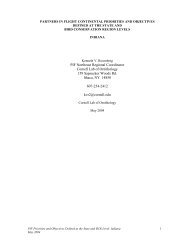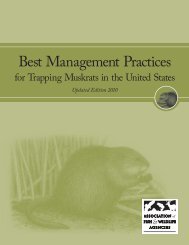Modern Snares for Capturing Mammals: - Association of Fish and ...
Modern Snares for Capturing Mammals: - Association of Fish and ...
Modern Snares for Capturing Mammals: - Association of Fish and ...
- No tags were found...
Create successful ePaper yourself
Turn your PDF publications into a flip-book with our unique Google optimized e-Paper software.
Issues <strong>and</strong> Concerns with Measuring or Recommending Breakaway ForceWe note that more research data is necessary to determine the minimum poundage ratingnecessary to hold different animals <strong>of</strong> interest, <strong>and</strong> the maximum rating allowable to release anyanimals that are to be avoided. There are 2 additional concerns about breakaway measurements:‣ Currently there is no st<strong>and</strong>ardized methodology <strong>for</strong> measuring breakaway <strong>for</strong>ce. Becausesnares, or snare parts, are manufactured, used, <strong>and</strong> sold by numerous individuals <strong>and</strong>companies, a st<strong>and</strong>ardized methodology <strong>for</strong> measuring breakaway tension wouldminimize the inconsistencies that currently exist.‣ When breakaways are required by law, or advertised by manufacturers, the protocol usedto rate the breakaway is <strong>of</strong>ten not specified. Specifying a number without a protocol <strong>for</strong>how it’s measured may not be useful, <strong>and</strong> if required by law, is difficult to en<strong>for</strong>ce. Thesame exact device measured in two distinct ways could yield substantially differentbreakaway ratings.We believe a st<strong>and</strong>ardized protocol is desirable, considering 3 important features:‣ To be accessible to the greatest number <strong>of</strong> potential users, the testing approach should beas mechanically simple <strong>and</strong> inexpensive as possible.‣ The protocol must not only specify the measuring apparatus, but also any important snarespecifics during testing such as loop size or the material to which the loop is attachedduring testing (e.g., a steel pipe).‣ The measuring apparatus <strong>and</strong> testing protocol should not contribute to significantvariability in results. When testing multiple devices <strong>of</strong> identical design, observedvariation in results should be attributable primarily to variability or inconsistency in thebreakaway device itself.Considering the factors above, we recommend the use <strong>of</strong> a static load test <strong>for</strong> ratingbreakaway devices. A static load test uses non-moving weight or non-jolting <strong>for</strong>ce applied tothe snare.There are numerous ways to design a static load test. Provided the principle <strong>of</strong> a static nonjolting<strong>for</strong>ce is maintained, most testing designs should provide acceptably comparableresults. However, there may still be some trade-<strong>of</strong>fs between the sophistication or cost <strong>of</strong> atesting system <strong>and</strong> the resulting precision. Because the acceptable cost <strong>and</strong> desired precisionwill vary depending on the situation or entity involved in the testing, herein we do notrecommend a specific testing apparatus, with 1 exception: some research has shown that thediameter <strong>of</strong> the snare loop during testing will influence breakaway ratings. Hence, <strong>for</strong>st<strong>and</strong>ardization, we recommend the snare loop be cinched around a 2-inch steel pipeduring testing. We note that a “2-inch pipe” has an actual outside diameter <strong>of</strong> ~ 2.4inches, while the inside diameter varies depending on wall thickness <strong>of</strong> the pipe.11Ver. 1.0
















